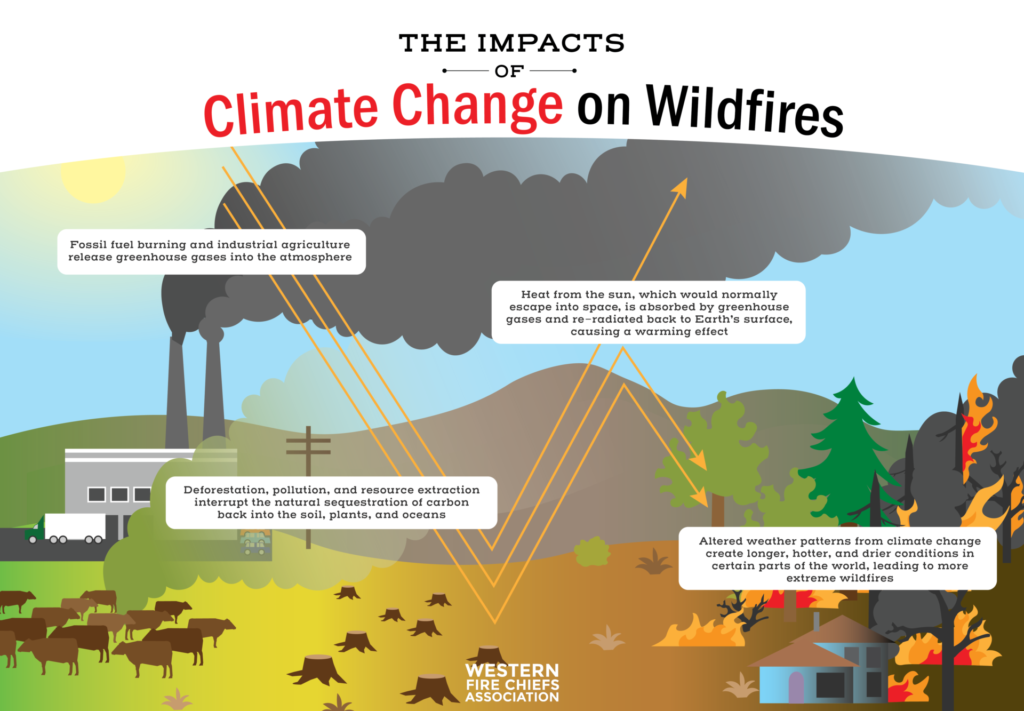Climate Change, Wildfires, And Alberta's Oil Production

Table of Contents
The Link Between Climate Change and Increased Wildfire Risk in Alberta
Rising Temperatures and Drier Conditions
Climate change is significantly altering Alberta's climate, leading to warmer temperatures and decreased precipitation. This creates a perfect storm for wildfires:
- Increased frequency of heatwaves: More frequent and intense heatwaves dry out vegetation, making it highly flammable.
- Longer fire seasons: Warmer springs and autumns extend the period when wildfires are most likely to occur.
- Lower soil moisture levels: Reduced precipitation and increased evaporation leave the soil drier, providing less resistance to fire spread.
- Increased vegetation dryness: Drier vegetation burns more easily and intensely, leading to larger and faster-spreading fires.
Data from Environment and Climate Change Canada reveals a clear upward trend in average temperatures and a decrease in precipitation in many parts of Alberta over the past several decades. This trend directly correlates with the increased frequency and severity of wildfires, exemplified by events like the 2011 Slave Lake fire and the 2016 Fort McMurray fire.
The Role of the Boreal Forest
Alberta's vast boreal forest, while beautiful and ecologically vital, is inherently susceptible to wildfires. Its characteristics exacerbate the impact of climate change:
- High density of flammable vegetation: The boreal forest's dense undergrowth and abundance of coniferous trees provide ample fuel for wildfires.
- Prevalence of peat bogs: Peat bogs, common in the boreal region, store vast quantities of carbon and burn intensely and for extended periods.
- Impact of insect infestations: Climate change is increasing the prevalence of insect infestations, which weaken trees, making them more vulnerable to fire.
Alberta's Oil Sands and Greenhouse Gas Emissions
Emissions from Oil Extraction and Processing
Alberta's oil sands industry is a major contributor to greenhouse gas emissions, a key driver of climate change:
- Methane emissions during extraction: Methane, a potent greenhouse gas, is released during the extraction and processing of oil sands.
- Carbon dioxide emissions from processing and transportation: The energy-intensive process of extracting and refining bitumen generates significant CO2 emissions. Transportation of oil also adds to the carbon footprint.
- Energy consumption in the oil sands: The oil sands industry requires vast amounts of energy, much of which is currently derived from fossil fuels, further contributing to greenhouse gas emissions.
Alberta's greenhouse gas emissions per capita are among the highest in Canada, largely due to the oil sands industry. The carbon intensity of oil sands production is significantly higher than that of conventional oil extraction.
The Carbon Footprint of Oil Consumption
The combustion of oil from Alberta, both domestically and internationally, contributes significantly to global greenhouse gas levels, perpetuating the cycle of climate change:
- Transportation sector emissions: A significant portion of oil consumption fuels vehicles, contributing to greenhouse gas emissions in transportation.
- Industrial emissions: Various industries rely heavily on oil for energy, resulting in substantial greenhouse gas emissions.
- Residential and commercial heating: In some areas, oil is still used for heating, adding to the overall carbon footprint.
Mitigation and Adaptation Strategies
Reducing Greenhouse Gas Emissions from the Oil Sands
Addressing the climate impact of Alberta's oil production requires focused efforts to reduce greenhouse gas emissions:
- Carbon capture and storage technology: Capturing CO2 emissions from oil sands facilities and storing them underground can significantly reduce emissions.
- Renewable energy integration: Transitioning to renewable energy sources for powering oil sands operations can lessen the reliance on fossil fuels.
- Improving extraction efficiency: Optimizing extraction processes can reduce energy consumption and lower emissions.
- Promoting energy conservation: Implementing measures to conserve energy throughout the oil sands value chain can minimize the carbon footprint.
Wildfire Prevention and Management
Effective wildfire prevention and management are crucial to mitigating the risks associated with increasing wildfire activity:
- Improved forest management practices: Strategic forest thinning and controlled burns can reduce the fuel load and lessen the intensity of wildfires.
- Early warning systems: Advanced monitoring and early warning systems can provide timely alerts, enabling faster response and evacuation efforts.
- Increased fire suppression resources: Investing in fire suppression equipment, personnel, and technology can enhance the effectiveness of wildfire control.
Investing in Climate Resilience
Long-term planning and investment in climate resilience are essential to adapt to the unavoidable impacts of climate change:
- Community planning: Developing resilient infrastructure and community plans that can withstand extreme weather events, including wildfires.
- Ecosystem restoration: Protecting and restoring ecosystems can enhance their resilience to climate change impacts.
Conclusion
The strong link between climate change, increased wildfire risk, and Alberta's oil production is undeniable. The increasing frequency and severity of wildfires in Alberta are a direct consequence of a changing climate, further exacerbated by the province's significant contribution to greenhouse gas emissions. Addressing this challenge requires urgent action on multiple fronts. We must significantly reduce greenhouse gas emissions from the oil sands while simultaneously investing in wildfire prevention, robust fire suppression strategies, and building climate resilience in our communities. Learn more about climate change, wildfires, and Alberta's oil production, and take action to mitigate climate change's impact on Alberta. Support sustainable energy initiatives to reduce Alberta's carbon footprint and advocate for policies that promote climate action and wildfire prevention. The future of Alberta's economy and environment depends on our collective commitment to responsible action.

Featured Posts
-
 Canelo Golovkin Fight Ppv Start Time Full Fight Card And More
May 31, 2025
Canelo Golovkin Fight Ppv Start Time Full Fight Card And More
May 31, 2025 -
 6 Definitive Rules For Polished Office Lunch Etiquette
May 31, 2025
6 Definitive Rules For Polished Office Lunch Etiquette
May 31, 2025 -
 Building A Good Life Practical Tips For Lasting Happiness
May 31, 2025
Building A Good Life Practical Tips For Lasting Happiness
May 31, 2025 -
 Glastonbury 2025 Complete Guide To Coach Travel And Resale Ticket Options
May 31, 2025
Glastonbury 2025 Complete Guide To Coach Travel And Resale Ticket Options
May 31, 2025 -
 March 27 2025 Thursday 5 Updates You Should Know
May 31, 2025
March 27 2025 Thursday 5 Updates You Should Know
May 31, 2025
